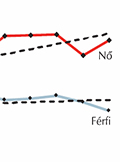The eLitMed.hu medical portal uses computer cookies for convenient operation. Detailed information can be found in the Cookie-policy.
Lege Artis Medicinae - 2017;27(01-02)
Content
[Behavioral therapy of diabetes mellitus]
[Diabetes is a model disease of behavior therapy. Its treatment is in the hands of patients for the most part, who must make decisions about their treatment every day, which affect their health status, prognosis and risk of developing complications of the disease. This common and complex treatment represents a significant burden for the majority of patients. In practice, a significant number of patients do not follow one or more cornerstones of self-management: physical activity, healthy diet, and use of medication. Based on research results diabetic patients' quality of life and psychological state is significantly worse than those of non-diabetics, which tend to deteriorate the medical collaboration and health status. In addition, certain psychiatric disorders (depression, anxiety, eating disorders), are also more common, which impair the quality of self-treatment as well. Early detection and treatment is of great importance, but in practice, only 10% of patients get psychological treatment, despite the fact that nearly 40% of them experience psychological symptoms. Based on the above, behavior remedial methods are highly recommended to be applied in the field of diabetes care in order upgrade quality of life, although they are not yet considered as commonly accepted in psychoeducation. Our aim is to summarise the practical and proven methods of behavioral remedies in addition to the literature review. In the case study demonstrate the authors the addition of transtheoretical model. The first order condition of self-management is the adoption of the disease and motivation, afterwards comes the teaching of theoretical and practical knowledge, and the ongoing diabetes education. ]
[Screening for depression and suicidal risk in family and general medical practice]
[According to both international and national studies the point prevalence of diagnosed major depression requiring treatment is 6-10 percent in general practice. As untreated depression is the most important risk factor for suicide, early detection and effective management of depression (especially depression which predisposes sui-cide) are critical in prevention. According to international and national studies the re-cognition of major depression in primary care significantly contributes to the decline of suicide mortality. In our article we present two short questionnaires used for re-cognising depression and acute suicide risk and we describe their use in family/ general practice. We aim to raise awareness of the need of a systematic, nationwide sui-cide prevention programme which is supported on government level as well. ]
[Results of the Comprehensive Health Screening of Hungary (MÁESZ) in 2016 and comparative results of 2010-2016]
[In accordance with the Hungarian health strategy, the authors introduce the results of the „Comprehensive Health Screening of Hungary” (MÁESZ) as of 2016 and the comparative results of 2010-2016. It has been again found that the Hungarian population is at high medical risk from multiple perspectives. The program is supported by 68 professional-scientific societies as well as by various secretary of states and the ministry. So far it has accomplished the complex screening of 159 576 residents and informed 375 879 residents about the right lifestyle, the protection of health and prevention of diseases on the ground. ]
[Diseases of the kidneys due to non-cancer mortality characteristics of Hungary between 2005-2014]
[The authors review the time of 10 years between 2005-2014 concerning the development of the mortality rate of kidney diseases in Hungary. They’ve compared the Hungarian mortality data with the ones from three other countries, namely Austria, the Czech Republic and Germany. The analyses included kidney diseases originated from hypertension, glomerulonephritis and tubulointerstitial kidney diseases, kidney failure and polycystic kidney diseases. They weren’t concerned about kidney tumors or diabetes originated kidney diseases because of the lack of data concerning the latter. The mortality data were retrieved from the KSH Demography Yearbook and the European Detailed Mortality Data-base (DMDB). The statistically examined causes of death only add up to 1.2% of the total causes of death, but with the aging of the population this proportion will surely grow. During the last 10 years, the mortality of cardiovascular diseases decreased significantly, namely the mortality of ischaemic heart disease and stroke, but the mortality of hypertension increased. These processes can also be seen in Austria, the Czech Republic and Germany. The mortality connected to primal kidney diseases decisively concerns people aged over 70. The glomerular diseases’ standardized rate is significantly higher in Hungary than in the compared countries. The tubulointerstitial kidney diseases’ mortality rate decreased over the last 10 years and we are in the middle of the international field in this regard. During the evaluation of the mortality of kidney diseases it is important to consider that in the statistics every death can only have one cause nominated, which can be (correctly) the basic disease causing the kidney disease or in other cases the kidney disease itself. This problem makes it more difficult to compare data internationally. Only 20-30 patients die of acute kidney disease on a yearly basis which is a low mortality rate even by international standards but the above-mentioned problem still exists. Of all of them the chronic kidney disease is the most significant one and between 2005-2014 the number of deaths and their rate connected to it decreased, but with the aging of the population the morbidity of kidney diseases will surely increase. Analyzing the data of all the primer kidney diseases it can be determined that between 2005-2014 the mortality rate showed a decreasing tendency, so our international situation can be viewed positively. It is important to note though that the mortality of this disease type includes patients of lower average age in Hungary than in the more developed countries. The mortality rate of polycystic kidney disease hasn’t changed significantly during the past 10 years. Although some patients live to many years, the average age of the dead is significantly lower compared to the ones of other kidney disease types. The cases below the age of 1 year of the latter add up to 10%. The comparison between the countries concerning the polycystic kidney disease shows that the standardized mortality rate is higher in Hungary.]
[Bayesian and frequentist T-test and ANOVA]
[T-test and ANOVA are just special cases of linear models. With these models measured values of a continuous variable (e.g. blood pressure) can be compared in two or more groups (e.g. treatment groups). In real life medical application of the frequentist linear models the data often fail the assumptions (e.g. normality and equal variances) originally needed to derive the mathematical equations and distributions for these models. Bayesian linear models are robust, flexible and transparent analogues and alternatives of the frequentist models. Bayesian statistical models can also be useful, when the data do comply with the prescribed conditions for the t-test or ANOVA. An advantage of the bayesian method is the possible incorporation of any prior knowledge into the models. It must be borne in mind, however, that there are many frequentist methods that can be used even if the distributions are not normal, or in the case of heteroscedasciticy or other model inadequacy as well. It is worth mentioning that even the frequentist Lasso (least absolute shrinkage and selection operator) is in near relationship with the Bayesian method, since it is a linear regression method, where the traditional fitting algorithm is modified with a constraint, and some information will be discarded in order to focus on the most relevant coefficients and make the model interpretation easy. Calculations were performed in R, primarily with the BayesFactor package developed by Morey and Rouder in 2015. ]
[Conference report: XXI. Annual Meeting of the Hungarian Psychiatric Association]
[The Hungarian Psychiatric Society's 2016 Annual Meeting was held in Siófok, Hungary, under the title The Changing Face of Psychosis. The diverse programme of the three-day conference was so rich that we often wished to be present in two or more interesting sessions at the same time.]
1.
Clinical Neuroscience
Is there any difference in mortality rates of atrial fibrillation detected before or after ischemic stroke?2.
Clinical Neuroscience
Factors influencing the level of stigma in Parkinson’s disease in western Turkey3.
Clinical Neuroscience
Neuropathic pain and mood disorders in earthquake survivors with peripheral nerve injuries4.
Journal of Nursing Theory and Practice
[Correlations of Sarcopenia, Frailty, Falls and Social Isolation – A Literature Review in the Light of Swedish Statistics]5.
Clinical Neuroscience
[Comparison of pain intensity measurements among patients with low-back pain]1.
Clinical Neuroscience Proceedings
[A Magyar Stroke Társaság XVIII. Kongresszusa és a Magyar Neuroszonológiai Társaság XV. Konferenciája. Absztraktfüzet]2.
3.
Journal of Nursing Theory and Practice
[A selection of the entries submitted to the literary contest "Honorable mission: the joys and challenges of our profession" ]4.
Journal of Nursing Theory and Practice
[End of Life and Palliative Care of Newborns in the Nursing Context]5.
Journal of Nursing Theory and Practice
[Aspects of Occupational Health Nursing for Incurable Patients ]











